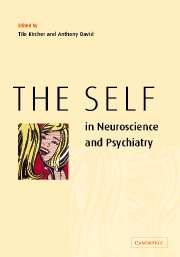Book contents
- Frontmatter
- Contents
- List of contributors
- Introduction: the self and neuroscience
- Part I Conceptual background
- Part II Cognitive and neurosciences
- 5 The multiplicity of consciousness and the emergence of the self
- 6 Asynchrony, implicational meaning and the experience of self in schizophrenia
- 7 Self-awareness, social intelligence and schizophrenia
- 8 The neural correlates of self-awareness and self-recognition
- 9 Autonoetic consciousness
- 10 The neural nature of the core SELF: implications for understanding schizophrenia
- Part III Disturbances of the self: the case of schizophrenia
- References
5 - The multiplicity of consciousness and the emergence of the self
from Part II - Cognitive and neurosciences
Published online by Cambridge University Press: 18 December 2009
- Frontmatter
- Contents
- List of contributors
- Introduction: the self and neuroscience
- Part I Conceptual background
- Part II Cognitive and neurosciences
- 5 The multiplicity of consciousness and the emergence of the self
- 6 Asynchrony, implicational meaning and the experience of self in schizophrenia
- 7 Self-awareness, social intelligence and schizophrenia
- 8 The neural correlates of self-awareness and self-recognition
- 9 Autonoetic consciousness
- 10 The neural nature of the core SELF: implications for understanding schizophrenia
- Part III Disturbances of the self: the case of schizophrenia
- References
Summary
Abstract
One of the most striking manifestations of schizophrenia is thought insertion. People suffering from this delusion believe they are not the author of thoughts which they nevertheless own as experiences. It seems that a person's sense of agency and sense of the boundary between mind and world can come apart. Schizophrenia thus vividly demonstrates that self-awareness is a complex construction of the brain. This point is widely appreciated. What is not so widely appreciated is how radically schizophrenia challenges our assumptions about the nature of the self. Most theorists endorse the traditional doctrine of the unity of consciousness, according to which a normal human brain generates a single consciousness at any instant in time. In this chapter we argue that phenomenal consciousness at each instant is actually a multiplicity: an aggregate of phenomenal elements, each of which is the product of a distinct consciousness-making mechanism in the brain. We then consider how certain aspects of self might emerge from this manifold substrate, and speculate about the origin of thought insertion.
Introduction
Schizophrenia is a complex and heterogeneous disease, incorporating at least three distinct subsyndromes: psychomotor poverty (poverty of speech, lack of spontaneous movement, blunting of affect), disorganization (inappropriate affect, disturbances of the form of thought) and reality distortion (Liddle, 1987; Johnstone, 1991). The reality distortion syndrome encompasses the so-called ‘positive’ symptoms of schizophrenia, which include auditory hallucinations, delusions of persecution and delusions of reference. Of these, thought insertion is arguably the most bizarre.
- Type
- Chapter
- Information
- The Self in Neuroscience and Psychiatry , pp. 107 - 120Publisher: Cambridge University PressPrint publication year: 2003
References
- 3
- Cited by



